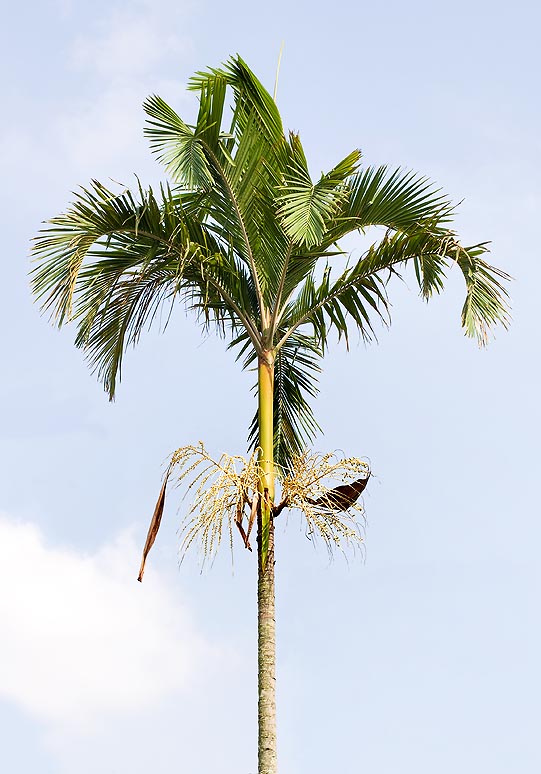Family : Arecaceae

Text © Pietro Puccio

English translation by Mario Beltramini

The Actinorhytis calapparia male flowers ripe before the female ones © Giuseppe Mazza
The name of the genus is the combination of the Greek words “aktis, aktinos” = ray, radiation, and “rhytos” = wrinkled, with reference to the striations of the endosperm which irradiate from the centre; the name of the species comes from the Malay name of the coconut (Cocos nucifera): kelapa.
Common names: calappa palm (English); pinang kelapa, pinang penawar (Malay).
The Actinorhytis calapparia (Blume) H.Wendl. & Drude ex Scheff. (1876) is a monoecious species with single thin trunk, 16-20 cm of diameter, erect, up to about 14 m tall, of greyish-brown colour, green in the upper, younger, part where are well visible the rings, trace of the joint of the fallen leaves, with a conical mass of aerial roots at the base in the older plants.
The leaves are paripinnate, strongly and elegantly curved, 2,5-3 m long, with the foliar base entirely wrapping the trunk for a height of about 1 m, forming a sort of elegant tubular capital of pale green colour.
The pinnulae, numerous and close to each other, up to about 40 cm long, are linear lanceolate with sharp or just bifid apex, of glossy dark green colour on the upper side, dotted by tiny scales on the lower one, and regularly inserted along the rachis in way to form a V-outline of the leaf.
The inflorescences are ramified under the leaves, initially erect, and then hanging, on a short peduncle, carrying cream coloured flowers of both sexes placed in the characteristic triad (a female flower amid two male flowers) in the first half, or little after, of the rachillae (secondary rachis in the ramified inflore- scences), in pair or only male flowers in the remaining part.
The inflorescence has the phenomenon of the proterandry, the male flowers ripe before the female ones, and this for helping the crossed fecundation. The fruits are ovoid, 6-8 cm long, red or reddish brown when ripe, and contain only one globular seed of 3-4 cm of diameter; the seeds (fresh) germinate in 2-4 months at a temperature of 24-28 °C, with adjacent germination and first leaf bifid, the growth is fast under the best conditions of cultivation.
Plant of great ornamental and scenic value, suitable only to tropical climates and, less, in the subtropical ones, it may bear, adult, temperatures close to the zero for very short time, but does not survive to prolonged periods of low temperatures, as may take place in the warm temperate climates.
It needs high humidity, atmospheric and in the soil, possibly acidic or neutral, rich of organic substance and well drained; when young, it prefers a partly shaded position, when adult, the full sun. It may be cultivated in pot for the decoration of greenhouses or vast luminous locations sufficiently humid, utilizing mould rich in organic substance, with addition of coarse sand or agri-perlite for improving the drainage; the watering must be distributed regularly, in such a way to keep the substratum constantly humid, and the temperature of 18-20 °C, or more.
In the Asian south-east, it is attributed of magical powers and for this reason, it is frequently cultivated; locally, they consume the core of the vegetative apex (palm heart) and the fruits are at time used in substitution of those of the Areca catechu in the betel.
Synonyms: Areca calapparia Blume (1843); Areca cocoides Griff. (1845); Seaforthia calapparia (Blume) Mart. (1849); Ptychosperma calapparia (Blume) Miq. (1855); Pinanga calapparia (Blume) H.Wendl. (1878); Actinorhytis poamau Becc. (1914).
→ For general notions about ARECACEAE please click here.
